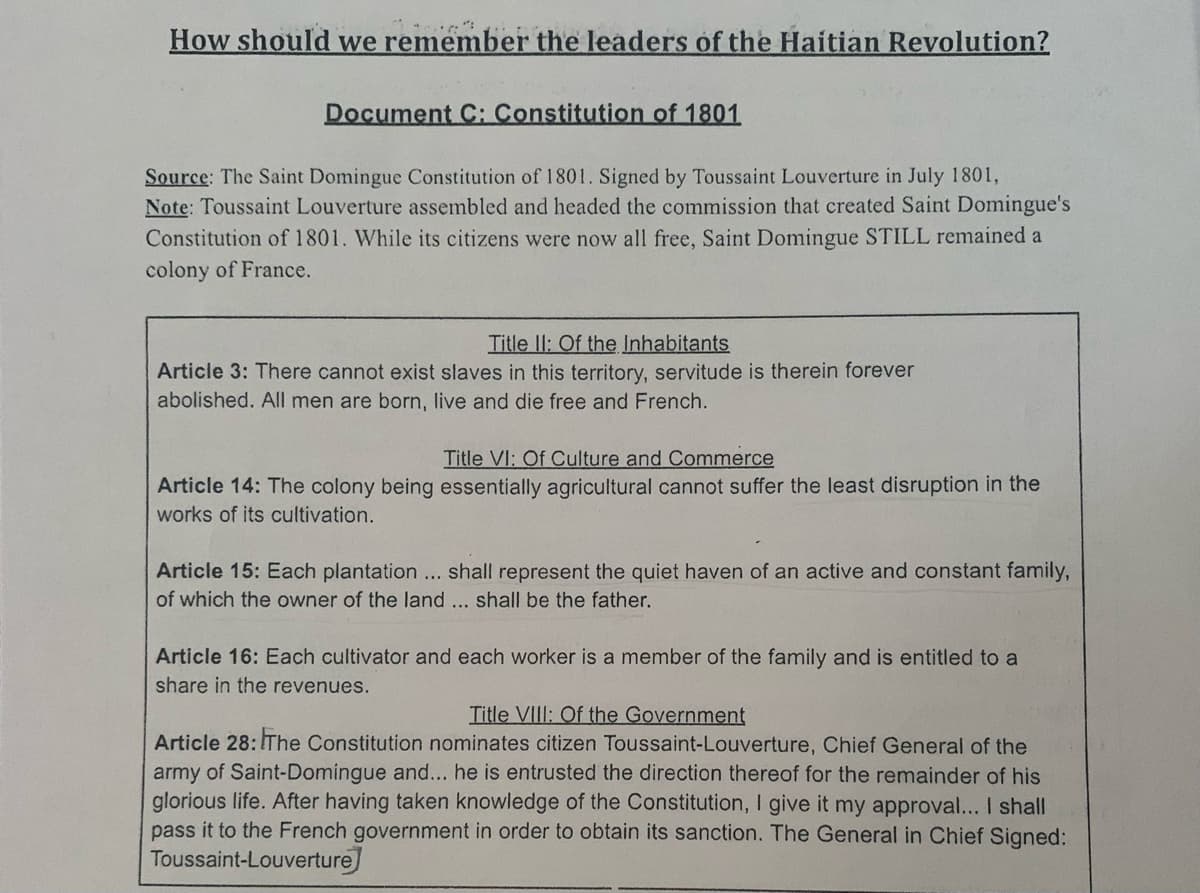Write an essay about Toussaint louverture and how you would remember him as either a - missionary commander - liberator of slaves - ruler of saint Domingue choose one and use two pieces of evidence and analyze them
Write an essay about Toussaint louverture and how you would remember him as either a - missionary commander - liberator of slaves - ruler of saint Domingue choose one and use two pieces of evidence and analyze them
Related questions
Question
Write an essay about Toussaint louverture and how you would remember him as either a - missionary commander - liberator of slaves - ruler of saint Domingue choose one and use two pieces of evidence and analyze them

Transcribed Image Text:How should we remember the leaders of the Haitian Revolution?
Document C: Constitution of 1801
Source: The Saint Domingue Constitution of 1801. Signed by Toussaint Louverture in July 1801,
Note: Toussaint Louverture assembled and headed the commission that created Saint Domingue's
Constitution of 1801. While its citizens were now all free, Saint Domingue STILL remained a
colony of France.
Title ll: Of the Inhabitants
Article 3: There cannot exist slaves in this territory, servitude is therein forever
abolished. All men are born, live and die free and French.
Title VI: Of Culture and Commerce
Article 14: The colony being essentially agricultural cannot suffer the least disruption in the
works of its cultivation.
Article 15: Each plantation ... shall represent the quiet haven of an active and constant family,
of which the owner of the land ... shall be the father.
Article 16: Each cultivator and each worker is a member of the family and is entitled to a
share in the revenues.
Title VIII: Of the Government
Article 28: IThe Constitution nominates citizen Toussaint-Louverture, Chief General of the
army of Saint-Domingue and... he is entrusted the direction thereof for the remainder of his
glorious life. After having taken knowledge of the Constitution, I give it my approval... I shall
pass it to the French government in order to obtain its sanction. The General in Chief Signed:
Toussaint-Louverture
![How should we remember the leaders of the Haitian Revolution?
Document A: Timeline of Abolition in Saint Domingue
Note: in 1789, the total slave population in Saint Domingue was 500,000. The French (European) population was
32,000 and the mixed race population was 25,000.
1789: The French Revolution begins.
1790: Free men of color in Saint Domingue proclaim themselves French citizens; The French
National Assembly grants full civic rights to free men of color.
1791: A slave revolt begins in the north of Saint Domingue, Toussaint joins the revolution and
serves as doctor to the troops; he also commands a small detachment of slave soldiers.
1792:/As a military commander, Toussaint gains a reputation for running an orderly camp and
for training his men in both guerilla tactics and the European shoulder to shoulder style
of war]
1794: The revolutionary government in France under Robespierre abolishes slavery in France
and all its colonies; Toussaint and Dessalines stop their revolt and now support the French.
1796: Toussaint, General Dessalines, and General Christophe organize an army against the
British/English, who are nervous about abolition spreading to their colony of Jamaica.)
1798: Dessalines and Toussaint defeat the British/English. Then in 1801 they conquered Santo
Domingo, the Spanish (east) portion of the island of Hispaniola.
1802: Napoleon sends 21,000 soldiers to Saint Domingue to reinstate slavery. Toussaint is
tricked into a negotiation meeting, is captured and sent by ship to a French jail. Dessalines
continues the fight against Napoleon and the invading French.
1803: Dessalines continues to battle against the invading Europeans and forces Napoleon and
the French to withdraw from Saint Domingue but Toussaint dies in a French jail.
1804: Victorious over the French, a free Haiti declares independence.](/v2/_next/image?url=https%3A%2F%2Fcontent.bartleby.com%2Fqna-images%2Fquestion%2F17effde9-7673-48ea-817e-3a52d0beea07%2F8ed2ed4a-46b1-4669-8a01-7e6d390e3a7f%2Fsmmdtjj_processed.jpeg&w=3840&q=75)
Transcribed Image Text:How should we remember the leaders of the Haitian Revolution?
Document A: Timeline of Abolition in Saint Domingue
Note: in 1789, the total slave population in Saint Domingue was 500,000. The French (European) population was
32,000 and the mixed race population was 25,000.
1789: The French Revolution begins.
1790: Free men of color in Saint Domingue proclaim themselves French citizens; The French
National Assembly grants full civic rights to free men of color.
1791: A slave revolt begins in the north of Saint Domingue, Toussaint joins the revolution and
serves as doctor to the troops; he also commands a small detachment of slave soldiers.
1792:/As a military commander, Toussaint gains a reputation for running an orderly camp and
for training his men in both guerilla tactics and the European shoulder to shoulder style
of war]
1794: The revolutionary government in France under Robespierre abolishes slavery in France
and all its colonies; Toussaint and Dessalines stop their revolt and now support the French.
1796: Toussaint, General Dessalines, and General Christophe organize an army against the
British/English, who are nervous about abolition spreading to their colony of Jamaica.)
1798: Dessalines and Toussaint defeat the British/English. Then in 1801 they conquered Santo
Domingo, the Spanish (east) portion of the island of Hispaniola.
1802: Napoleon sends 21,000 soldiers to Saint Domingue to reinstate slavery. Toussaint is
tricked into a negotiation meeting, is captured and sent by ship to a French jail. Dessalines
continues the fight against Napoleon and the invading French.
1803: Dessalines continues to battle against the invading Europeans and forces Napoleon and
the French to withdraw from Saint Domingue but Toussaint dies in a French jail.
1804: Victorious over the French, a free Haiti declares independence.
Expert Solution
Step 1
In the late eighteenth century, a self-knowledgeable slave without army education compelled Napoleon to go out of Haiti and directed his nation to freedom. The notable chief of this slave rebellion became Toussaint L'Ouverture, and every so often referred to as black Napoleon.
Trending now
This is a popular solution!
Step by step
Solved in 2 steps
